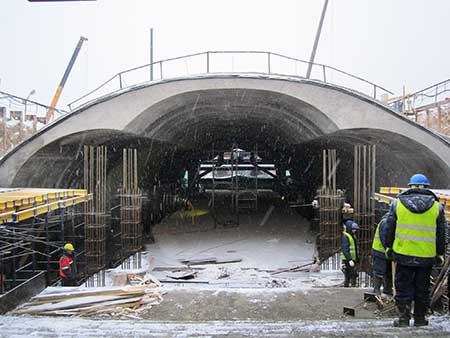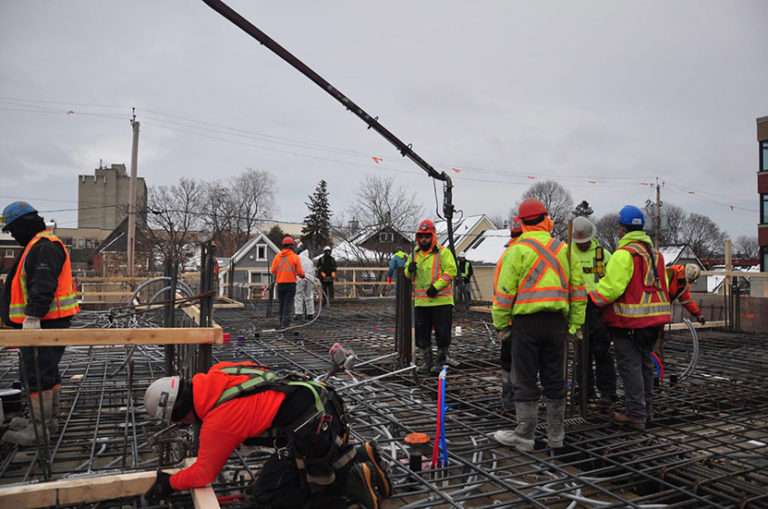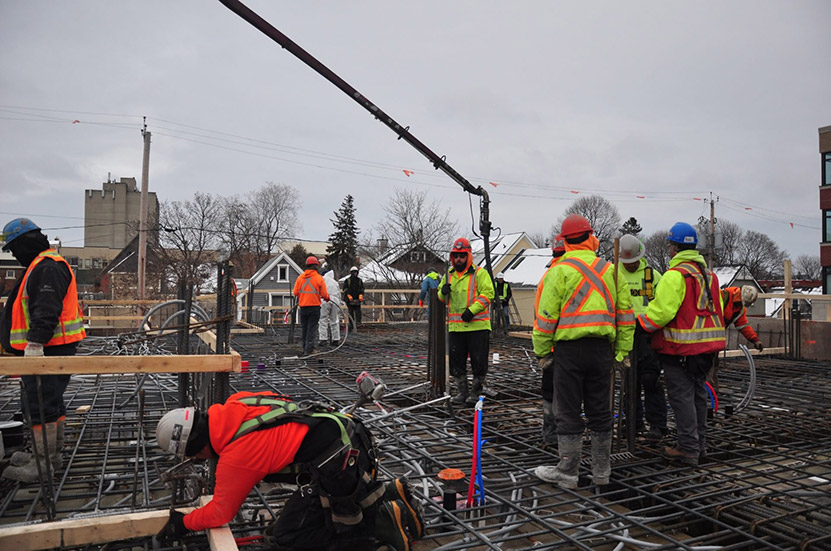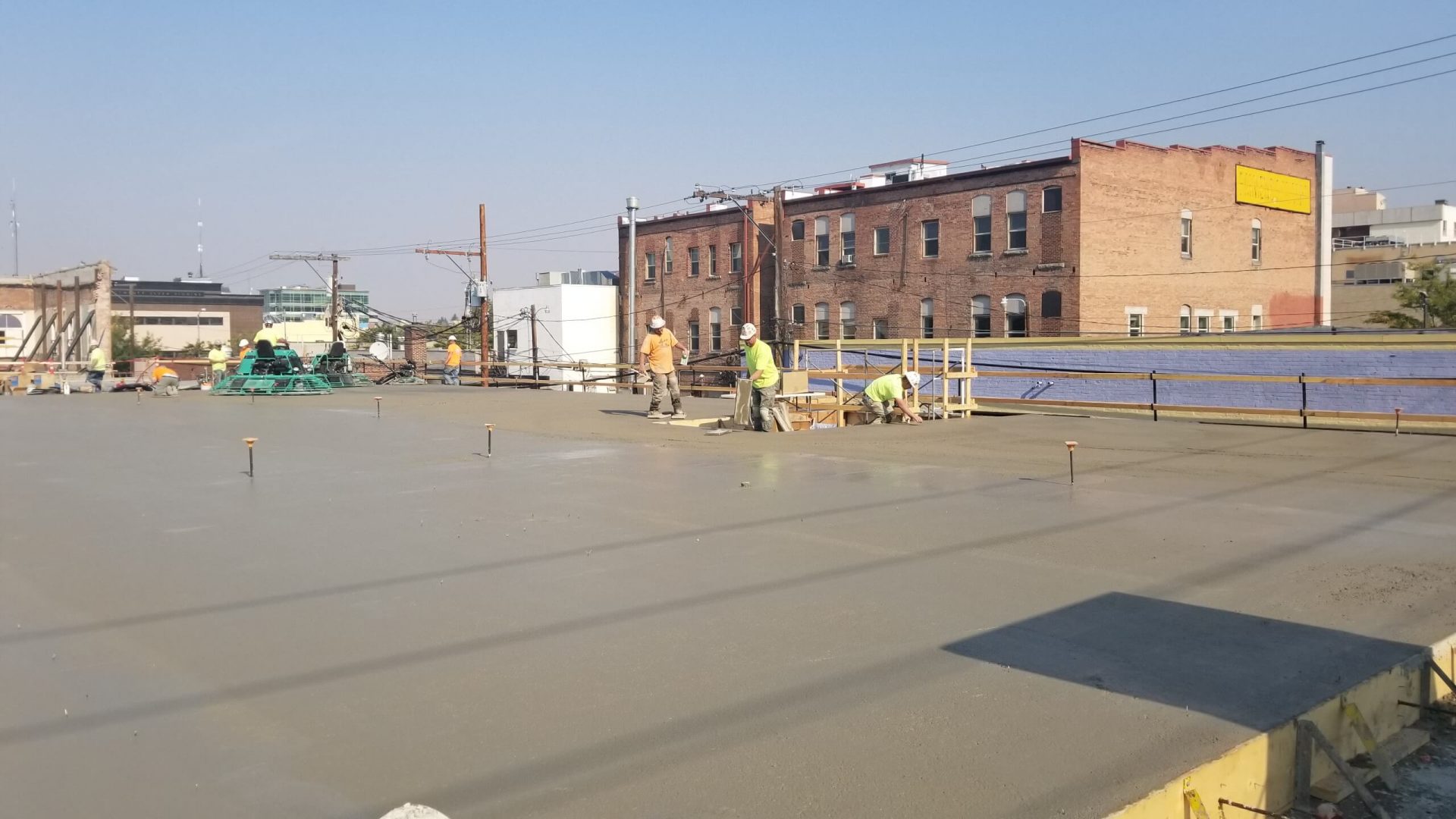Although contractors might wish they did not have to perform tasks like pouring concrete in winter, construction does not stop when temperatures drop. As the concrete temperature fluctuates in response to changing weather conditions, the concrete is subject to different curing conditions resulting in sporadic strength gain. Contractors must prepare long before the weather changes to adequately protect fresh concrete. Having the right equipment ready to use at the jobsite, such as tarps and blankets, can help avoid unnecessary delays and unsafe development of cold-weather concrete.
Explore 12 Futuristic Technology Trends Solving Concrete's Biggest Challenges.
What Is Considered “Cold Weather” When Dealing With Concrete?
In the American Concrete Institute (ACI) 306: Guide to Cold Weather Concreting “cold weather” is defined as three or more consecutive days of low temperatures, specifically outdoor temperatures below 40°F (4°C) and air temperatures below 50°F (10°C) for more than any 12 hours.
What Is the Minimum Temperature for Concrete Pours?
Knowing what ACI considers “cold weather” in construction, the minimum temperature for concrete pours would be around 40°F (4°C). If concrete is poured below this temperature, the curing process will slow down significantly, and concrete may not achieve the required strength. If the temperature drops below freezing (32°F or 0°C), the water in the concrete mix can freeze, leading to cracking and structural issues. In some cases, the concrete could even go to waste because of the wear. Fresh concrete can freeze at 25°F (-4°C), so it is important to warm fresh concrete until it has the proper compressive strength measurement.

7 Mistakes to Avoid When Working With Cold Weather Concrete
To help you avoid structural issues while pouring concrete in Winter and project delays, it is important to familiarize yourself with the dos and don’ts of cold weather concreting. Take a look at these 7 common mistakes to avoid when placing concrete in cold weather.
Need a plan for cold weather concreting? Learn more here!
1. Placing Concrete on Frozen Ground
When placing your concrete, the placement of your slab factors into the effectiveness of the concrete curing conditions. Frozen ground can settle when thawed, causing the concrete to crack. The fresh concrete closest to the ground will also cure slower than the surface, meaning the top of your slab will set while the bottom stays soft. This is a problem because concrete with different temperature gradients doesn’t develop strength adequately, leading to cracking and possible structure disaster.
2. Allowing your Concrete Temperature to Drop Below Freezing
Concrete should be kept warm (around 50°F (10°C)) in order to cure properly. Fresh concrete can freeze at 25°F (-4°C), so it is important to warm fresh concrete until it has the proper compressive strength measurement. This can be done more efficiently using a concrete temperature and maturity meter, such as SmartRock®.
3. Using Cold Tools
It is just as important to keep your tools and building materials warm as it is the concrete. If forms or tools are too cold, it could alter the concrete that comes into contact with them. This can negatively affect the strength development of your slab and the quality of cold-weather concrete.
4. Not Using Heaters to Increase Concrete Temperature
Concrete needs to stay warm in order to continue curing and develop strength. If your slab gets too low in temperature, curing stops altogether. Portable heaters deliver extra heat into the ground and directly on the concrete, ensuring concrete keeps curing and gaining strength. Be careful when using heat; improperly heating the concrete can result in a weak structure.
5. Sealing Cold Weather Concrete in Inclement Conditions
Concrete sealers make your concrete more resistant to weather exposure and other outside elements. If you are placing concrete in cold weather, the best option is to get a sealer that works well in extreme weather conditions based on the recommendation of the producer/manufacturer. Sealing typically should not be done if the temperature is below 50°F (10°C).
6. Misjudging Daylight
During the colder months, the amount of daylight lessens. It is essential to use your time wisely, as running behind schedule could lead to more problems. Daylight not only gives you an abundance of light, it also results in warmer temperatures. If concrete must be placed before or after daylight hours, be sure to refer to #4 on this list.
7. Not Using Real-Time Concrete Temperature Sensors
Monitoring the temperature of cold-weather concrete is important to ensure the production of high-quality concrete that meets thermal control plan specifications. Several common problems can occur if one does not pay proper attention to the strength development of the concrete. Among these problems are:
- Freezing of concrete at early ages.
- Lack of required strength.
- Rapid temperature changes.
- Inadequate protection of the structure and its serviceability.
- Improper curing procedures.
These problems related to pouring concrete in Winter can be avoided by using real-time temperature sensors to ensure the optimal temperature of concrete is maintained during the curing stages. Making sure your concrete does not freeze, your temperature differential is maintained under specific limits, your maximum temperature doesn’t achieve maximal limits, and your concrete gains strength properly are important in any mass concrete application for cold weather.
*Editor’s Note: This post was originally published in October 2017 and was updated for accuracy and comprehensiveness on September 5, 2024.









6 Responses
Thanks for the tip that concrete should be kept warm in order to avoid uneven curing and cracking. I’m planning to get a patio built near my garden later this year and now that I know that cold weather isn’t that applicable for concrete, I’ll probably consider getting the job done months earlier. By then I will still have time to hire a concrete finishing service to make the flooring of the patio much more aesthetically pleasing.
Thanks for the help
According to many construction experts, working on concrete on cold weather is certainly difficult. Pouring can be difficult as they are also being exposed humidity and wetness of cold weather.
George Hazel: Any frozen layer of subgrade will shrink when it thaws. Whether it’s directly in contact with the concrete or it’s below the stone course, it will affect bearing integrity to some degree.
Is it safe to pour a concrete building slab onto a compacted gravel base that rests on a frozen sub-grade?
Great article!